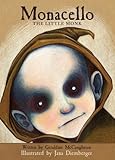
Price: £7.99
Publisher: Phoenix Yard Books
Genre: Fiction
Age Range: 8-10 Junior/Middle
Length: 64pp
Buy the Book
Monacello: The Little Monk
Illustrator: Jana DiembergerMonacello: The Little Monk brings together the only author to have won the Whitbread/Costa three times, an illustrator whose work for the book was her graduate show piece, and an innovative publisher of children’s books founded in 2009. Phoenix Yard claim they are ‘not afraid of pushing boundaries, particularly in design and illustrative style’. Their press release also tells us, for good measure, that Jana Diemberger is a tattoo enthusiast and a medal winning boxer.
Monacello is a foundling, abandoned in a straw-filled crate at the door of a convent in Naples, perhaps in medieval times. Only Sister Clementa offers him any compassion. For the other nuns, the tiny ‘snuffling, scuttling, scuffling little creature’, wrapped in his oversized monk’s habit, is an ugly pest, a goblin, a devil, a gremlin. When Monacello hears stories of Mary and Jesus, another who started life in ‘a box of straw’, he longs to find his own mother. His search takes him into the streets and around the stalls of the city. At first the Neapolitans see him as an omen, the Bad Luck Boy. Their curses and blows drive Monacello into the labyrinthine Undercity, where the ‘centuries have piled one city on top of the one before’. Here, he sets up his own kingdom with his friends, the hundreds of cats which range the watery passageways beneath the streets. Before long, he shares his new domain with the homeless Napolina, a girl whose ragged clothes include a patch of sky blue over her heart. Through an impulsive act of kindness towards Napolina and the strong spirit which beats beneath her wretchedness, Monacello’s fortunes change. In time, he becomes the citizens’ Good Luck Boy.
McCaughrean’s reworking of a classic Italian folk story reads aloud wonderfully with its tale-teller’s seeming simplicity and its frequent alliterations and internal rhymes. The menacing illustrations of Jana Diemberger, an artist of Italian/Austrian upbringing, will also invite shared talk between listener and reader. Her choice of viewpoint is often startling and dramatic. The dark, crater-eyes set in the pale moon of the foundling’s face haunt the pages. Only once is that face lit by a wan smile when Monacello has reached out to warm Napolina’s icy sadness. No doubt financial constraints required the book to be backed in stiff card rather than the board covers it deserves, since it is designed with such care and this layered tale will demand to be revisited many times.
One frustration, though. The driving pulse of the story has been Monacello’s search for his mother. Turning the closing pages in expectation of a meeting, we discover only the publisher’s promise of Book II: ‘Amid the strangers and dangers of Naples, lies the secret Monacello longs to find.’ But readers have known that since page 10. They’ll want to know about his mother now.



